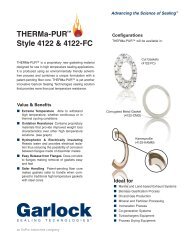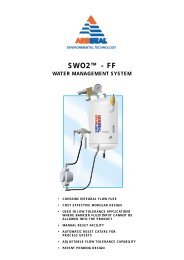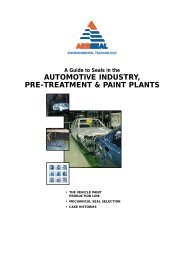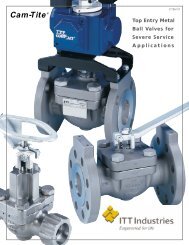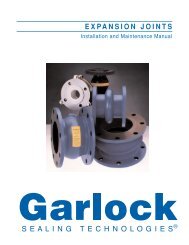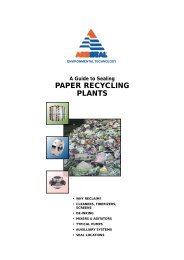A guide to sealing sulphuric acid plants - AR Thomson Group
A guide to sealing sulphuric acid plants - AR Thomson Group
A guide to sealing sulphuric acid plants - AR Thomson Group
Create successful ePaper yourself
Turn your PDF publications into a flip-book with our unique Google optimized e-Paper software.
SSUULLPHUURRIICC ACCID IINNDDUUSSTTRRYY<br />
AESSEAL ®<br />
SULPHURIC ACID<br />
INDUSTRY<br />
L-UK/US-SULPH-02<br />
IN 4512 - 01/2002<br />
6<br />
A General Overview of the<br />
Contact Process<br />
Fig 1<br />
Air<br />
Turbo<br />
Blower<br />
Mesh Pad<br />
Air<br />
Filter Drying<br />
Tower<br />
98-99%<br />
Acid S<strong>to</strong>rage<br />
Sulphur<br />
Melter<br />
Settler<br />
Sulphur<br />
Burner<br />
Molten<br />
Sulphur<br />
Steam<br />
Hot Gas<br />
Filter<br />
Waste Heat<br />
Boiler No 1<br />
© Copyright 2002 AESSEAL plc All Rights Reserved.<br />
Steam<br />
Waste Heat<br />
Boiler No 2<br />
4 Pass<br />
Converter<br />
Cold IP<br />
Exchanger<br />
Hot IP<br />
Exchange<br />
Absorbing<br />
Tower<br />
Mist<br />
Elimina<strong>to</strong>rs<br />
Secondary<br />
Economizer<br />
Acid<br />
Coolers<br />
Interpass<br />
Absorber<br />
Circulating<br />
Tank<br />
Final<br />
Absorbing<br />
Tower<br />
Economizer<br />
Superheat<br />
Final<br />
Absorber<br />
Circulating<br />
Tank<br />
Exit Gas<br />
S<strong>to</strong>ck<br />
Acid Coolers<br />
As energy prices have risen in recent decades, the valuable energy generated during the<br />
Sulphuric Acid production process has become a valuable commodity. Major changes<br />
have been made in process and plant design <strong>to</strong> maximize energy recovery and then use<br />
this heat <strong>to</strong> generate high-pressure steam and/or electricity. This secondary function<br />
complicates the plant and it’s operation, but sharply reduces the cost of the <strong>acid</strong><br />
produced. A modern Sulphuric Acid plant has extensive boiler and steam systems in<br />
addition <strong>to</strong> the <strong>acid</strong> streams. Process economics and legislation reducing allowable SO2<br />
emissions have resulted in more complex <strong>plants</strong> with higher conversion efficiencies. The<br />
older ‘single absorption’ process has been largely replaced by the ‘double absorption’<br />
process (also called ‘double catalyst’) which increases yield of <strong>acid</strong> and reduces<br />
emissions. A modern Sulphur burning plant may achieve conversion efficiencies of 99.7%<br />
or better, and <strong>plants</strong> using smelter gases 99.5%.<br />
A typical flowchart for a Sulphur burning double absorption Sulphuric Acid plant is shown<br />
in Figure 1. Molten Sulphur is pumped (using a heated pump and lines) <strong>to</strong> burners in a<br />
furnace, where it meets dried air from the Turbo-blower (fan). Where roasted Sulphur ores<br />
are used rather than elemental Sulphur, fluidized beds or rotary roasters are used in the<br />
furnace. Spent Sulphuric Acid from other production processes may also be decomposed<br />
<strong>to</strong> provide SO2 gas.<br />
The gas produced (containing around 11% or so of SO2) is passed through a heat recovery<br />
boiler then filtered before being passed <strong>to</strong> the converter. Vanadium catalyst beds in the<br />
converter encourage the reaction of SO2 with Oxygen <strong>to</strong> produce SO3 (Sulphur Trioxide).<br />
The reaction is exothermic, and the gas passes through several heat exchangers as it<br />
makes its way down the converter, controlling the temperatures at each catalyst bed <strong>to</strong><br />
obtain optimum speed and efficiency of the conversion. The converter operates at<br />
temperatures over 400°C (750°F), and is usually brick-lined. In the double absorption<br />
process, gas from part-way down the converter is cooled, then passes through an interpass<br />
absorber before being reheated and sent back <strong>to</strong> the final stage of the converter.<br />
After the final stage, the gas passes through another heat recovery exchanger then <strong>to</strong> a<br />
final absorber.<br />
In the absorbers the SO3 laden gas is passed through 98% <strong>to</strong> 99% Sulphuric Acid,<br />
increasing the concentration of the <strong>acid</strong>. The <strong>acid</strong> circulates back <strong>to</strong> a tank, where it is<br />
diluted with water (or dilute <strong>acid</strong>) then the excess drawn off as product. The process is<br />
again exothermic, and the <strong>acid</strong> is cooled as it circulates. Absorbers are usually lined with<br />
<strong>acid</strong>-resistant brick.<br />
In some <strong>plants</strong> the gas passes through an Oleum <strong>to</strong>wer before going <strong>to</strong> the absorber,<br />
where 98% <strong>to</strong> 99% <strong>acid</strong> is added <strong>to</strong> the circulating <strong>acid</strong> instead of water. Oleum is then<br />
produced and drawn off as product. Product <strong>acid</strong> may be pumped <strong>to</strong> s<strong>to</strong>ck tanks, and then<br />
<strong>to</strong> road or rail tankers.



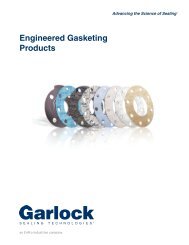
![VCS Flange Gasket [1.03 MB] - AR Thomson Group](https://img.yumpu.com/12044617/1/190x245/vcs-flange-gasket-103-mb-ar-thomson-group.jpg?quality=85)

![PGE Flange Gasket Product Brochure [1.04 MB] - AR Thomson Group](https://img.yumpu.com/12044595/1/190x245/pge-flange-gasket-product-brochure-104-mb-ar-thomson-group.jpg?quality=85)
